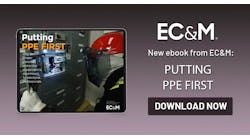An electrocution is an event in which a person dies from receiving an electric shock or series of shocks. In 2020, 126 workers were electrocuted. Many people who receive a shock seem unharmed. That outcome is more common where the shock occurs with a 120V branch circuit than it is with, say, a 480V feeder. But the hazard of electric shock should not be disregarded if it’s just a residential lighting circuit or an office receptacle circuit — people can also die from 120V shocks alone.
Electrocution is not the only consequence of electric shock. Many survivors find they are unable to work or their lives are irrevocably damaged in some other way. Some of the consequences include nerve damage, bone fractures, iritis, hypertension, brain damage, and secondary reactions that result in non-electrical injuries.
Safeguarding others
You must assess the risk to two parties: the electrician(s) involved in the actual work and everybody else. Let’s start with everybody else. Improper wiring is one reason people receive a shock. Some examples:
- Using the equipment grounding conductor (EGC) as a circuit return path. This was done at a plant close to the Illinois/Tennessee border. Rather than run a neutral conductor for their lighting, they used the metallic raceway as the neutral. People got shocked all the time because the unbalanced current was flowing in the equipment grounding (bonding) conductor instead of the power wiring.
- Another bad move is to wire around (instead of through) a GFCI. This can be done by mixing the load/line conductors or by pigtailing the neutral. Don’t wire a GFCI the way you might wire a normal receptacle; wire it the way a GFCI is wired.
- Bonding neutral and ground on the load side. This sends undesired current to flow through metallic objects.
- Failing to bond metallic objects. The NEC is full of specifics, and you can rewrite them all into one sentence. If a metallic object doesn’t carry current, connect it to other metallic, non-current-carrying objects to eliminate dangerous differences of potential.
Unguarded wiring is another hazard. Where something is readily accessible, follow the relevant NEC requirements for safeguarding others against shock or make it no longer readily accessible.
An unsafe electrical condition is a third reason people receive a shock. Some electricians have a misplaced hero mentality, in which they save the company time by needlessly “working hot.” This doesn’t endanger just the electrician behaving so foolishly; it also puts others at risk. Sometimes adjacent equipment is inadvertently energized, shocking another person.
People have been badly shocked when trying to help a slumped-over coworker whose body, unbeknownst to them, is conducting electricity. Practice lockout/tagout [NFPA 70E, Art. 120] or go through the process of obtaining an Energized Electrical Work Permit [NFPA 70E, Art. 130].
What actions or inactions can you think of that may endanger other people while you are working? Make a point of assessing the intended work to produce a list of these relevant to that particular job. Make sure to communicate to people in the area what you are doing and what the dangers are. Putting up a red tape barrier for the duration of the work is also not a bad idea.
Protecting yourself
Much of the thought about protecting oneself from shock focuses on what steps to take when doing the work whether hot [Art. 130] or not [Art. 120]. But the protection starts before the work does. Consider:
- Personal protective equipment (PPE). Insulating blankets have protected thousands of electrical workers from shock. But how do you know if your insulating blanket still insulates? The standard advice is to inspect it before you use it. The problem there is you arrive at the job without a spare, so then what do you do? Inspect it before putting it away, and you avoid this problem. Look for any kind of chemical or mechanical damage, such as abrasions or tears. Also, look for embedded wire scraps or similar. Other forms of PPE, such as insulating gloves, should also be inspected before being put away. Improperly stored PPE has a far greater chance of failing, so pay attention there.
- Insulated tools. The insulation can be damaged by any number of things. You might see mechanical damage in the form of a chunk missing. You might not see damage from electrical “punctures” that degrade the insulation. If you left your insulated screwdriver on a truck dash all day, is that insulation still good? If someone used your insulated pliers to hold a part they sprayed with solvent, those pliers might not be insulated anymore. If an insulated tool has been dropped from elevation, does the insulation still have its integrity? If your insulated tool is of the two-color design, there will be a visual indication the tool is no longer usable as insulated. Purchasing this design means you don’t have to guess.
- Uninsulated tools. The common wisdom is to use only insulated tools on energized circuits. That means uninsulated tools can be used only on unenergized circuits. But what happens when the worn tip on your uninsulated screwdriver slips and the shaft subsequently makes contact with an energized terminal? Your first line of defense is to inspect your tools periodically and replace any that are not in “like new” condition. Your second line of defense is to assess the work area and consider the proximity of nearby energized circuits. When working inside a typical panel, space is tight and the likelihood of unintentional contact is high. Are you prepared for that?
- Non-locking ratchets and sockets. Whether due to cheap design or excessive wear, a ratchet/socket combo may be an accident waiting to happen. Dropping a socket across 2-phase terminals may result in your vaporization, but what if you drop it onto only one energized surface? How do you safely retrieve it? You can see the safety predicament here. Avoid this by using high-quality, industrial-grade ratchets, extensions, and sockets.
- Fasteners. Sometimes other people leave a hazard for the next person to deal with. You see evidence of this in screw heads that have a damaged slot (typically from using a worn screwdriver) or in a hex nut that is rounded (often from using pliers or using an adjustable wrench backward). When you see a fastener like this — and there is any energized equipment within arm’s reach — treat the situation as a shock hazard. Maybe you can use a properly inspected electrical blanket between your damaged fastener and the energized terminals. Assess what other measures you can take. Then remove the fastener slowly and deliberately, so you don’t end up having to use an extractor tool or other extreme measure to remove it. Replace the fastener with a new one, and use the proper tool with the recommended torque to apply the new fastener.
The fastener problem often is not isolated. What if the whole cabinet is full of screws with damaged heads? It is not safe in this condition. Write a work request to have it powered down and repaired. Note also, this poor workmanship is a sign that other problems likely exist.
Electrical work environment
The fastener problem is part of the electrical work environment. Here are some other parts:
- Tripping and slipping hazards. Keep the area free of debris, and properly secure any portable cords. The last thing you want to do is “catch yourself” by grabbing something that’s energized. Nor do you need others doing that around you.
- Poor lighting. The average age of an electrician has been past the “reading glasses age” for many years now. Older eyes need more light. Ensure the area is well-lit with no shadows, especially inside tight spaces like wiring cabinets. Use portable LED work lamps and/or an LED head strap lamp where permanent lighting cannot be made adequate.
- Miniature labeling. Presbyopia is a natural consequence of aging. The lens loses flexibility, and at around age 40, there’s a noticeable loss in the ability to focus on small things like print. For most electricians, this issue is not just annoying. It’s dangerous. Reading glasses can help only so much. If labels are consistently small, explain to management this is a violation of the 1990 Americans with Disabilities Act (ADA). Printing labels and instructions in Arial 11 or similar is an easy accommodation to make.
Why not in NFPA 70E?
You may be wondering why none of the preceding information is in NFPA 70E. If you read the standard from a “forest” perspective instead of a “trees” perspective, you see the information is baked in there. For example, practicing the concepts of awareness and self-discipline [Sec. 110.5] would lead you to see much of what this article discussed. In this age of distraction, awareness is an unusual skill to have. But it is key to being safe around electricity — even before you get there.
Mark Lamendola is an electrical consultant based in Merriam, Kan. He can be reached at [email protected].




